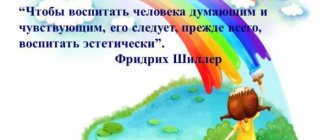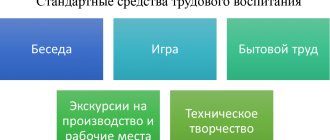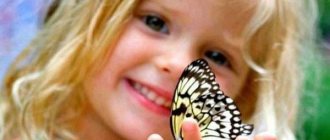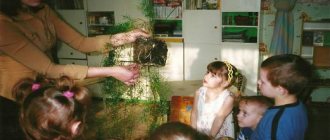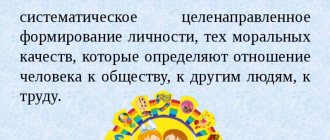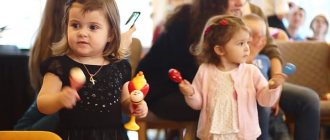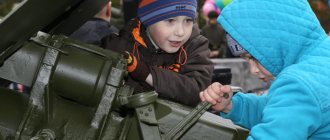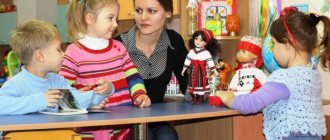Purpose of music education in preschool educational institutions
Definition 1
Musical education is a specially organized process of influence through the means of musical art, through which the aesthetic development of a child is realized, the foundations of his general culture are formed, and value guidelines are developed.
Musical education has a positive impact on personal development.
Music influences the formation of the creative component of the individual and contributes to the development of the creative foundations of his activity. and this, in turn, leads to the harmonious development of the child and the formation of all his qualities necessary for successful social life.
The main purpose of music education is the comprehensive harmonious development of the child’s personality. A number of subgoals of music education can be distinguished:
Are you an expert in this subject area? We invite you to become the author of the Directory Working Conditions
- Introducing a preschooler to the art of music. The child learns the basics of musical creativity, learns the aesthetic perception of music, and develops musical taste.
- Mastering the fundamentals of musical culture. Through it, the child learns the basics of general culture and forms his own views, attitude towards art, and develops his own line of cultural behavior.
- Development of musical abilities of a preschooler. Through musical education, a sense of rhythm, musical memory, auditory attention and perception are formed, which ultimately contributes to the formation of musical taste.
- Formation of the need for music. The need for musical creativity leads to the creative development of a preschooler.
- Implementation of different types of musical and artistic creativity of preschool children. In this way, the child can assert himself and realize himself in a creative direction, satisfy his creative needs.
Music classes in preschool educational institutions are aimed at developing in preschoolers a love of music, an interest in art, and the development of adequate musical taste and orientation skills in musical information.
Finished works on a similar topic
Course work Musical education of preschool children in preschool educational institutions 470 ₽ Abstract Musical education of preschool children in preschool educational institutions 260 ₽ Test work Musical education of preschool children in preschool educational institutions 200 ₽
Receive completed work or specialist advice on your educational project Find out the cost
Methods and techniques for musical education of preschool children
The following methods are used to form a musical culture:
- Contrastive comparison - a system of tasks has been developed that are based on listening to different interpretations of the same work. By contrast, students learn to understand the meaning of a work and break it down into its component parts.
- Assimilation to the character of the sound consists of an emotional adjustment to the sound and in expressing one’s attitude towards the works being listened to. Similarity can manifest itself in a variety of forms: singing along, dancing, choosing clothes, etc.
- Tactile assimilation - the teacher touches the child’s hand to set him up to listen to the musical playback for maximum insight into its essence.
- Mimic assimilation - when listening to works, children look at the teacher and expect his assessment of what is happening. To develop musical taste, you will need to show emotions that correspond to the nature of the work. For example, it is appropriate to smile, make a serious face, and show passion. Children in preschool age are subconsciously drawn to adults, copying their behavior and emotions.
- Intonation assimilation - when listening to compositions, you need to express your attitude in words and replicas. In preschool age, it is difficult for children to grasp the meaning of words, phrases or sentences if they explain the essence of the composition in difficult to understand language. Therefore, it is better to express your attitude to music in simple words that are understandable for children, but saturated with bright emotional coloring. They act directly on the subconscious, bypassing the stage of mental comprehension of what is heard.
- Color comparison - when listening to a composition, you need to show the students cards with colors and associate a certain color with the general mood of the work. For example, when listening to a calm composition, the color blue is shown; for an active and sound-rich song, you need to show the color red. When listening to subsequent melodies, you should ask the children what color this or that song is associated with.
Quickly teach children how to count examples within 10 and 20
Forms of organizing music education in preschool educational institutions
Musical education in preschool educational institutions is implemented in the following forms:
- Musical lessons. They are educational musical activities. During music lessons, the child’s intellectual, moral, aesthetic and cultural development is carried out. Musical classes include different types and areas of musical activity: singing, playing instruments, dancing, listening to music of different genres, getting acquainted with the work of great composers, mastering musical literacy.
- Independent musical activity of preschool children. It is associated with children demonstrating their creative abilities. They need to be encouraged to do this. Children apply their musical knowledge and focus it on their interests and needs.
- Music in everyday life. Music is becoming an important component of all types of preschool activities. It permeates all routine moments of the day. For example, music turns on when children are charging, it accompanies the gameplay. Getting ready for a walk can be accompanied by singing, etc. In addition, the preschool educational institution organizes holidays that are accompanied by musical performances.
- Musical education in the family. It is important to establish interactions with parents and form a unified direction of musical education. If music accompanies all the routine moments of a preschooler in a preschool educational institution, then at home it should also accompany the child. For example, a mother can find out what music the teacher plays during exercise and use it. At night you can sing a lullaby, etc. It is important that music be a constant component of a child’s life. An episodic nature will not give the desired educational effect.
The purpose and objective of educational activities
The goal and task of educational activities is to instill in preschoolers an interest in art, the ability to understand musical information , genres, musical forms , and to contribute to the formation of artistic taste in children.
Educational activity is the main form of educational activity in kindergarten and the educational process is carried out through direct instruction. In everyday life, the indirect guidance of the music director , teacher , and parents in the musical education of children .
Direct teaching in everyday life is not completely excluded, but it should be limited. Any musical communication with a child should be built on joint activity, partnership, encouraging his initiative in every possible way, which is especially important when children exhibit independent musical expressions . Music in the everyday life of a kindergarten combines all forms of musical activity : holidays, entertainment, morning exercises.
So, the form of organizing music education in the everyday life of a kindergarten provides for two types of guidance from the teacher , music director , and parents: direct and indirect. During games, educational exercises, and walks, music can be played at the request of both children and adults.
But in entertainment, holidays, morning exercises, this happens, as a rule, on the initiative of the teacher; at the same time, he must, of course, take into account the capabilities, interests and passions of the children. The interaction of the entire teaching staff is one of the signs of a highly effective organization of the educational process.
The music director creates conditions for children to acquire knowledge, skills and abilities in various types of musical activities , and the teacher helps to consolidate them.
In order for music to become firmly established in children’s lives, the music director needs to build interaction not only with the team of teachers, but also with parents. To do this, certain work is carried out with parents, during which it is necessary to ensure that they become conductors of the child’s cultural formation. Children and adults love general forms of interaction , and these are holidays, entertainment, competitions, quizzes.
Club work also contributes to the emergence of independent musical activity in children, both in a group and at home with their parents. the accumulated musical experience into everyday life in accordance with his interests and desires.
The emergence of independent musical activity in kindergarten is one of the indicators of a high level of development of children, characterized by certain musical skills and abilities , the ability to transfer a variety of musical activities into everyday life.
The child must be able to apply the accumulated musical experience , developed musical skills and abilities in new conditions, in independent musical activities according to his interests and desires.
The structure of a music lesson in a preschool educational institution
Music classes at preschool educational institutions consist of the following components:
- Introductory part. It is aimed at preparing preschoolers to become familiar with music. In the introductory part of the lesson, you can include physical education components: performing movements to music, performing dance steps. This stimulates the preschooler’s musical activity and makes music lessons more productive.
- Listening to music. This part is focused on developing preschoolers’ skills in aesthetic perception of musical creativity and the formation of musical perception.
- Singing and song creativity. Children sing songs of different genres and also learn to compose songs on their own. Independent composing of a song motivates a preschooler’s interest in the art of music and helps to reveal his creative potential.
- Learning to play musical instruments. Typically, instruments are selected that are accessible to a specific age group. The teacher demonstrates their sound and shows the basics of playing melodies. Then the children themselves try to master playing this or that instrument.
- Dance activity. Dancing promotes the development of musical rhythm and creates a positive attitude towards music, because dancing is fun.
- Game activity. It is not a component of every music lesson, but may be included periodically. The game helps to absorb musical information more productively.
Types of musical activities
The standard defines age-appropriate activities, including musical activities for children.
In infancy (2 months - 1 year) - this is direct emotional communication with an adult, manipulation with objects and cognitive research activities, perception of music, children's songs and poems, motor activity and tactile-motor games.
At an early age (1 year - 3 years) - these are object-based activities and games with composite and dynamic toys, experimenting with materials and substances (sand, water, dough, etc.), communication with an adult and joint games with peers under the guidance of an adult, self-service and actions with household tools (spoon, scoop, spatula, etc.), perception of the meaning of music, fairy tales, poems, looking at pictures, motor activity.
For preschool children (3 years - 8 years) - this is a gaming activity, including role-playing games as the leading activity of preschool children, as well as games with rules and other types of games, communicative (communication and interaction with adults and peers), cognitive - research (studying objects of the surrounding world and experimenting with them), perception of fiction and folklore, self-service and basic household work (indoors and outdoors), construction from various materials, including construction sets, modules, paper, natural and other materials, visual arts (drawing, modeling, appliqué), musical (perception and understanding of the meaning of musical works, singing, musically rhythmic movements, playing children's musical instruments) and motor (mastery of basic movements) forms of activity of the child.
Based on the age-appropriate types of activities proposed by the Standard, it becomes possible to specify the forms of musical activity with children of early and preschool age (table). Please note that the proposed forms of a practice-oriented nature primarily grow out of the child’s cultural practices.
Conditions for the effective organization of music education in preschool educational institutions
In order for musical education to be productive, a number of conditions for its organization must be observed:
- Taking into account the age and individual characteristics of preschool children when planning a music lesson;
- Focus on the musical development of preschool children not only during music lessons, but in everyday life;
- The content of music classes should reflect the purpose of music education;
- The results of a preschooler’s musical development should be noticeable in the child’s daily activities - he transfers his knowledge and skills into his life activities;
- The teacher does not have an active educational influence on the musical development of the preschooler. The teacher identifies himself as an equal partner in joint musical activities, giving the child maximum independence in musical knowledge and development.
Get paid for your student work
Coursework, abstracts or other works
What are the benefits of music as an educational tool?
Songs and melodies are practically the only art form that children can properly appreciate at such a young age. Even in the first months of life, babies react to melodies and can express their feelings about what they hear with their emotions. Through a lullaby, an attitude towards loved ones and art is formed.
Important
It is important to make music accessible to such a young age. For preschoolers, it is very difficult to listen to, understand and evaluate a piece of music with a duration of more than 5-7 minutes. Children simply will not be able to sit for more time in attention; this must be taken into account when planning lessons.
To solve the problem, you need to select short fragments for listening with maximum ease of comprehension. It is better to take those parts and passages that are used on television for intros to programs, in films, and in theatrical productions. Their impact on the subconscious has already been tested for years and is highly likely to cause a strong emotional response, as well as maximum results in the musical education of preschoolers.
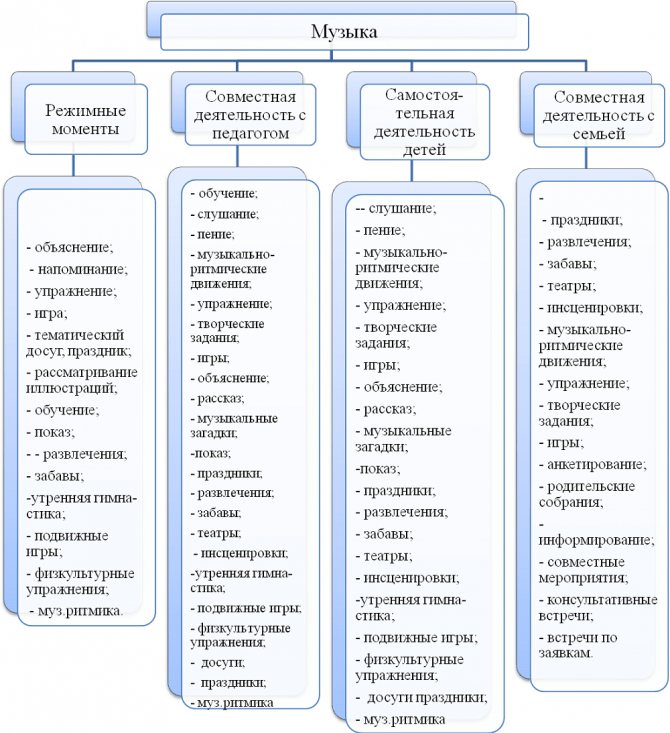
More diagrams on the topic “Music in kindergarten”.
The tasks of musical education are carried out: through singing, listening to music, musical-rhythmic movements, musical-didactic games. In older groups, the kindergarten education program provides for another means - playing musical instruments, in particular, the metallophone.
Each means that a teacher uses when carrying out the process of musical education, training and development of a child is a type of active, accessible to the child, artistic activity in the field of musical art.
Listening to music is an active internal process of concentration, requiring the mobilization of children's feelings, thoughts and cognitive abilities, united by the experience of a musical work. The child experiences various feelings in connection with the impact of music on him and comprehension of its content. This is a process of emotional-imaginative cognition, since it is carried out through an artistic and musical image. As a result, an attitude towards the image is formed, which is subsequently transferred to reality. Listening to music comes in different forms:
♦ as an integral part of any musical lesson, musical evening of leisure, holiday;
♦ as a special activity;
♦ as a methodological teaching technique.
Before learning a song with the children, the music director sings it to the children, and the children listen. Musical works for games, dances, and composition exercises are presented in the same way. The music director plays the piece, together with the children, determines its character, the number of parts, and draws attention to the most striking features.
In the form of a special lesson, listening is given with the aim of enriching children with musical impressions, accumulating and expanding their musical experience.
As a methodological technique, listening to music is used to help children learn to sing, play, and dance.
Singing is the active process of reproducing a melody with the voice and experiencing the content of the song. This is the main type of musical activity for preschool children.
All children from the age of two can and want to sing. While performing songs, they feel the music more deeply and express their emotions more actively. When choosing songs, it is necessary to take into account the age of the children, their vocal capabilities, level of musical development, as well as the educational orientation of the content of the songs.
Musical-rhythmic movements are active activities that reflect the nature of music in movement. Musical-rhythmic movements include musical games, dancing and exercises. The basis of musical-rhythmic education is the development in children of the ability to perceive musical images and the ability to reflect them in movement.
Musical-didactic games are a musical-sensory activity of a child, during which he learns to distinguish the properties of musical sounds, musical means of expression, and musical genres.
Playing children's musical instruments - metallophone and drums - is useful for the development of musical abilities: ear for music, sense of rhythm and musical memory.
Each means of musical education is associated with the development of musical perception. Together they instill in a child a love of music, deepen his perception and understanding of the environment, evoke a certain attitude towards him, and form musical taste. Each of the mentioned means of musical education has its own specifics, which is reflected in the teaching methodology. For example, if a teacher performs a song before the children start singing, then they will strive to imitate, perceive the work as a whole, and as a result will perform it better.
Preliminary listening to a song and its melody creates a general mood, restores previously formed temporary connections in the auditory analyzer of the cerebral cortex and helps the child correctly select the first sound. THEM. Sechenov pointed out that the memory for a vivid sensation is stronger the more recent it is, the more real the sensation, the fresher the impressions.
Preliminary listening to music for dancing or playing restores the musical image as a whole, affects the auditory and motor analyzers, and adjusts the child to the appropriate tempo and rhythm of movement. The very process of moving to music is an active process of perceiving music.
The specificity of each means of musical education is determined by its relationship to a specific type of musical art. Therefore, the content of software skills is built in accordance with the basics of this type of art. Thus, singing belongs to the field of choral art. Therefore, the content of program singing skills comes from the musical and theoretical foundations of choral singing.
Musical-rhythmic movement generally relates to the art of choreography and mainly to the basics of musical-rhythmic education. Therefore, the content of program movement skills comes from the foundations of musical-rhythmic education - rhythmics.
Listening to music is associated with seven types of art. It is based on concert and performing activities.
In the musical education of children, all of these means are interconnected. For example, singing, as mentioned above, involves both preliminary listening to the song and listening to it in the process of learning and performing. At the same time, singing in games and round dances is accompanied by movements.
Each means of musical education influences the others, and together they serve to develop musical abilities.
Listening to music develops a child's musical perception and helps him distinguish musical works. Since listening involves recognizing a piece of music, it contributes to the development of children's musical ear and especially its emotional component.
Singing—reproducing a melody with the voice—also contributes to the active development of musical and auditory perceptions. It develops both a modal sense (a sense of tonic, correct tuning) and a musical-rhythmic sense, since there is no melody without rhythm. Movement requires the child mainly to coordinate his actions with the nature of the music, with its tempo and rhythm, that is, he must simultaneously listen to the music. The same thing happens when children play musical instruments.
Thus, singing affects the success of movement, movement affects the success of singing, and listening affects both. All three main means of musical education act in the same direction - the development of musical abilities. In music classes, they are all necessarily used, since various forms of activity contribute to better assimilation of program skills.
The content of music education in kindergarten includes:
♦ objectives of musical education for each age group for all types of activities;
♦ program repertoire for all types of activities;
♦ program requirements for all types of activities;
♦ organizational forms of musical activity;
♦ methodological techniques for working with children for each age group.
Modern technologies in musical education of preschool children
A special approach in this area of education requires the use of innovative methods and technologies. Modern inventions facilitate and determine the variety of activities of a teacher.
Thus, when listening to melodic compositions, presentations and videos are widely used. Such visibility and expanded capabilities allow you to better perceive and understand information conveyed through music.
When learning dance movements and rhythmic exercises, videos on relevant topics are used.
These methods arouse greater interest in children and contribute to better development of musicality.
The accumulation of musical experience and culture is facilitated by the technology of development of music perception by O. P. Radynova.
